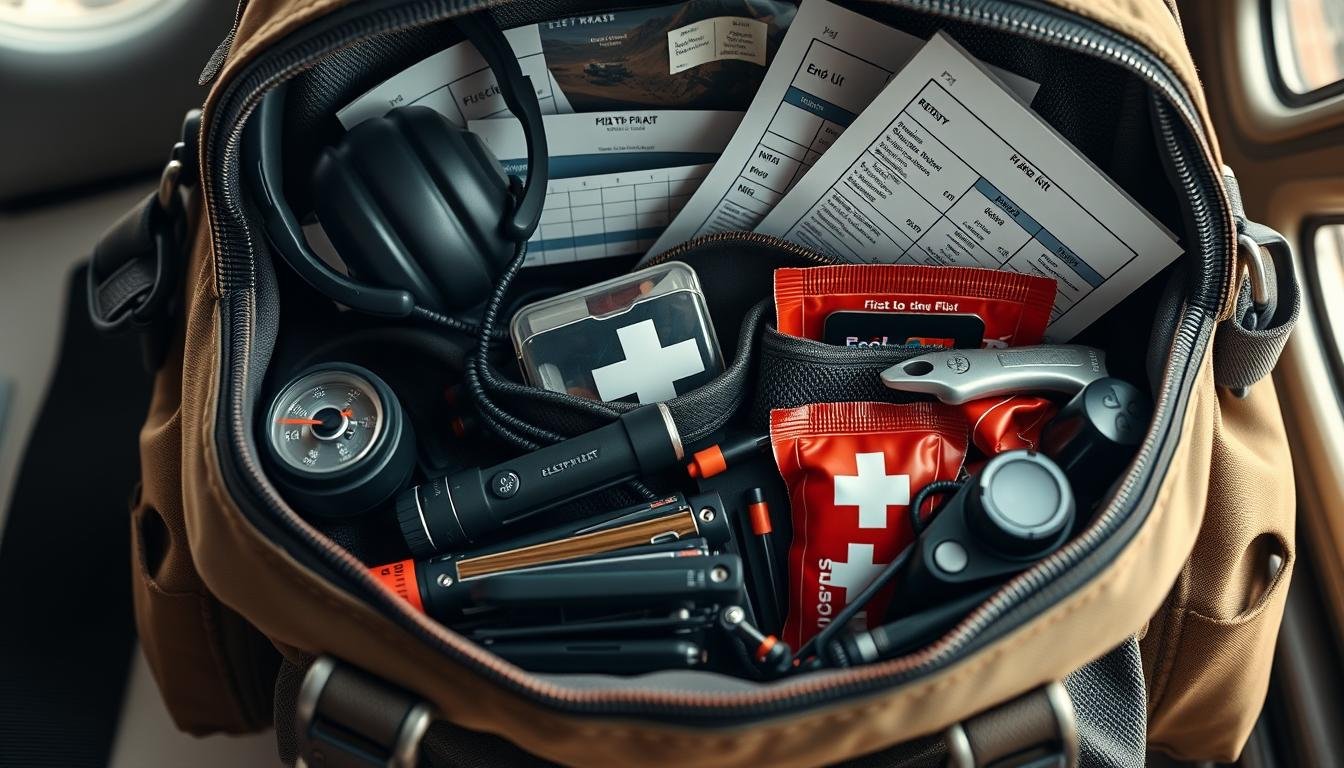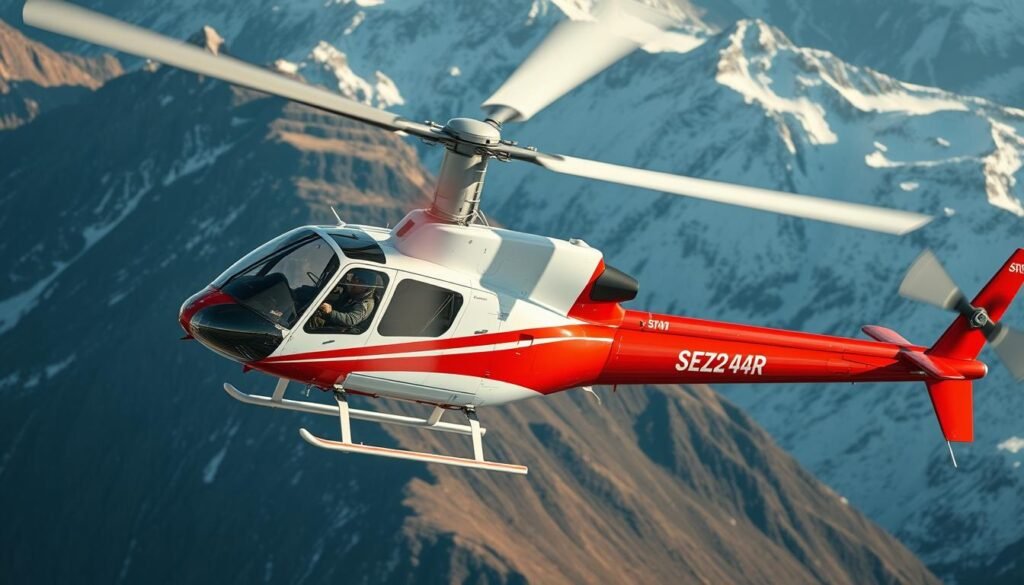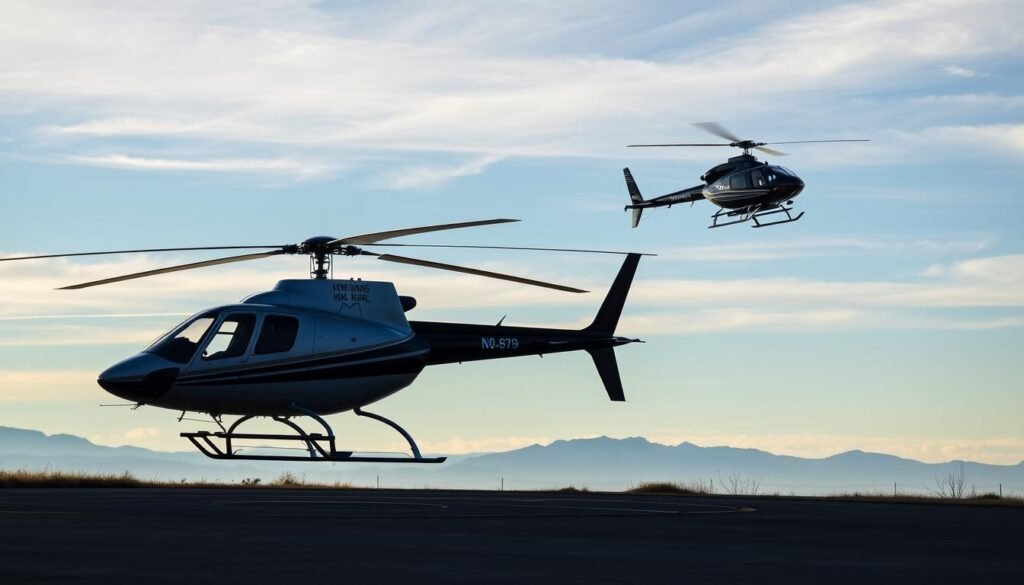Could a simple bag change the outcome of a tense mission? This introduction outlines the baseline items and habits that keep pilots ready for rapid, high-stakes missions.
The right setup blends trusted brands and smart redundancy. Items like a Bose A30 or David Clark headset, an iPad with ForeFlight, paper sectional backups, a kneeboard, and a reliable multitool form the core essentials.
Redundancy matters. Spare batteries, charging cords, a handheld airband radio, and non-polarized sunglasses help avoid small failures that become big delays. Practical checks — fuel sampling, inspection mirrors, and a clear bag layout — speed action in tight windows.
For a deeper run-down of useful components and a recommended packing approach, see a useful guide to flight bag essentials.
Key Takeaways
- Pack redundancy: backups for comms and power reduce risk.
- Balance weight and readiness: select multiuse items that save space.
- Use an EFB with paper backups to maintain navigation if electronics fail.
- Include night and low-light tools like a red/white flashlight and headlamp.
- Preflight checks such as fuel testing and inspection mirrors prevent delays.
Understand The Mission: Safety-First Intent For Every EMS Flight
Consistency in layout and habits keeps crews effective when minutes matter most.
Standardized placement for headset, radio, flashlight, fuel tester, and kneeboard reduces search time during critical phases. Crews store these items in fixed spots so tasks remain repeatable in day or night ops.
Redundancy is intentional. Two power sources, paper sectionals to back an iPad with ForeFlight, and a handheld airband radio bridge communications gaps. A headlamp with red mode and a compact preflight flashlight preserve night vision during ramp-to-cockpit transitions.
Training and brief reviews shape the loadout. Experience-driven adjustments after post-mission debriefs refine what goes in the bag and how the aircraft is configured for rapid turnarounds.
| Focus Area | Practical Action | Benefit |
|---|---|---|
| Layout | Fixed compartments for key items | Less cockpit clutter, faster access |
| Redundancy | Backup power, paper charts, handheld radio | Continued ops if electronics fail |
| Night Ops | Headlamp with red mode, compact flashlight | Preserve night adaptation, safer approaches |
| Human Factors | Preloaded kneeboard notes and local frequencies | Quicker turnarounds, fewer errors |
Survival items—first aid, hydration, and small tools—remain part of standard planning. Pilots treat these elements as mission essentials, not extras, because real incidents can extend duty time unexpectedly.
Build The Flight Bag Foundation
A compact, organized flight bag turns preflight minutes into confident readiness. Choosing a purpose-built model with padded headset and device compartments saves crucial time and protects sensitive gear.
Choose A Purpose-Built Flight Bag With Headset And Device Compartments
Dedicated pockets keep a headset, tablet, handheld radio, and backup charts separated and padded. Bright interiors help crews find small items fast in a dim hangar or cockpit.
Organize Essentials For Quick Cockpit Access
Pilots pre-stage AA/AAA batteries, adapters, pens, and a compact notepad so nothing gets hunted for when ATC calls. External side pockets let a fuel tester and flashlight be pulled without unpacking the whole bag.
Balance Weight And Space For Dynamic EMS Operations
Weight and footprint matter. Pick a rigid, compact bag that stands up in tight spaces and stays tidy across vehicles and pads. A zip pouch for spare batteries, an adapter, and a small multi-tool prevents loose items from scattering during turbulence.
- Fast setup: padded compartments present headset, iPad, and radio.
- Visibility: bright linings and modular pockets speed retrieval.
- Durability: reinforced handles and tough fabric extend service life.
Communications And Hearing Protection
Clear communications and proper hearing protection form the backbone of safe, long-duty operations.
Choosing the right setup reduces fatigue and keeps transmissions intelligible during high workload periods. Simple checks at run-up often solve problems that seem like hardware failures.

ANR Versus PNR: Comfort, Noise Fatigue, And Clarity
Active noise reduction cuts low-frequency rotor and engine noise and eases fatigue during long legs. It often improves clarity for long shifts.
Passive noise reduction headsets stay rugged and budget-friendly. They require no batteries and are simpler to maintain.
TSO Considerations And Proven Models
TSO markings, like TSO‑C139, show an FAA-tested baseline and are common in professional settings. Many teams prefer certified gear for predictable performance.
David Clark models remain a durable PNR standard. The Bose A30 is widely cited for premium ANR, comfort, and clear comms during extended duties.
Adapters And Spare Batteries For Headsets And Panels
Many panels use U174 connectors. Crews carry GA-to-LEMO and helicopter adapters so a favorite headset fits any assigned aircraft.
Spare AA/AAA batteries live in a labeled pouch. A quick pre-mission comms check of mic gain and squelch can rule out panel settings before blaming a headset.
| Topic | Action | Benefit |
|---|---|---|
| ANR vs PNR | Choose ANR for long legs; PNR for rugged use | Reduced fatigue vs. simple reliability |
| Certification | Prefer TSO-marked models | Known performance baseline |
| Adapters & Power | Carry U174 and GA adapters; spare batteries | Interoperability and uninterrupted ANR |
| Run-Up Checks | Verify mic gain, squelch, and boom placement | Faster troubleshooting and clearer transmissions |
Navigation Tools And Sectional Backups
A balanced mix of digital and printed navigation prevents surprises when electronics falter. This section covers how an EFB, protected charts, and basic planning tools work together to support safe operations.

EFB Setup: iPad With ForeFlight For Planning And Situational Awareness
ForeFlight on an iPad Mini centralizes routing, weather, NOTAMs, and geo-referenced plates for clear situational awareness during a flight. Teams standardize file folders so any crew can pull company routes and hospital coordinates quickly.
Paper Sectional Charts And Approach Plates As Backup
Paper sectional charts and approach plates ride in a protected sleeve. Instructors note sectionals update every 56 days, so crews swap sets on schedule to keep paper current.
Kneeboard For Notes, Frequencies, And Checklists
A sturdy kneeboard holds pens, a blank clearance sheet, local frequencies, and a small tablet mount. Mounting the iPad to the board reduces head movement and helps maintain a tight scan of instruments.
E6B And Plotter For Fundamental Planning Skills
E6B and a plotter verify wind correction, fuel burn, and time/distance numbers when electronics are down. These tools reinforce core navigation skills that save time during training, checkrides, and real missions.
- An iPad with ForeFlight streamlines route planning and geo-referenced plates.
- Protected paper backups keep navigation going if the tablet reboots.
- E6B and plotter validate planning math and serve as reliable fallbacks.
Power, Cables, And Redundancy
Staged power solutions reduce surprises during extended legs and unexpected diversions. A compact power kit keeps the EFB and comms alive so crews spend less time troubleshooting and more time flying.

High-Capacity Backup Battery For iPad And Phone
A 20,000 mAh-class power bank with PD fast charging can refill an iPad several times and top off a phone mid-flight. Fast charging shortens turnaround time and helps crews stay mission-ready between calls.
Charging Cords, Adapters, And Panel Power Options
Pilots stage Lightning and USB-C cables, a compact 12V adapter, and spare AA/AAA cells in a single zip pouch. Certified cords and labeled bundles speed connection and reduce intermittent failures.
- High-capacity PD bank: keeps EFB and phone alive through diversions.
- Preflight-test cables to avoid frayed, intermittent cords.
- Panel USB is handy, but external batteries provide true redundancy.
- Labeled, right-angle cords prevent snags near controls.
- Store AA/AAA with the power kit for headsets and small devices.
The power kit lives in the same pocket of the bag so pilots never dig during short final. Before shift start, make sure the bank itself is fully charged—a ten-second check saves hours later.
Visibility, Sunglasses, And Night Operations
Smart eyewear and measured lighting keep the cockpit clear and the crew focused. Good choices cut glare, preserve instrument readability, and protect night adaptation.

Non-Polarized Sunglasses To Preserve Instrument Readability
Non-polarized sunglasses prevent display washout and keep anti-glare instruments readable in bright sunlight. Thin temple frames—styles like Flying Eyes or Ray-Ban—fit comfortably under a headset and reduce pressure points during long legs.
Sunglasses should live in a hard case inside the bag to stay scratch-free and ready for sudden sun exposure.
Cockpit Flashlight With White/Red Modes
A compact flashlight with white and red modes helps with preflight checks and inside-cockpit work. Bright white reveals details for inspections; red preserves night vision when returning to the panel.
Crews test lamp brightness in the actual aircraft at night to avoid reflections on windscreens and to find levels that do not distract.
Headlamp With Red Light Option For Hands-Free Night Work
A hands-free headlamp that offers a red option tracks head movement so pilots can see tasks while keeping both hands free. Using the same AAA batteries across the headlamp and flashlight simplifies swaps in the field.
“A simple preflight check—lens cleanliness and lamp battery levels—avoids degraded vision at the worst possible moment.”
- Non-polarized sunglasses prevent display washout and preserve chart readability.
- Thin temples improve comfort under a headset for extended wear.
- Dual-mode flashlight supports inspections and night-adapted cockpit work.
- Headlamp straps that rest around the neck offer quick, hands-free light.
Preflight And Fuel Quality Tools
Small, reliable instruments for fuel and inspection make quality assurance fast and repeatable.

A fuel tester with a built-in cowl screwdriver lets crews check fuel color and screen for contaminants during sumping. Different airports supply varied fuel stocks, so a quick check guards engine health before any flight.
Fuel Tester And Screwdriver For Quality Assurance
A clear fuel tester confirms correct fuel type and reveals water or debris before it reaches the engine. The integrated screwdriver saves trips back to a toolbox for common fasteners during preflight.
Extendable Inspection Mirror For Hard-To-See Areas
An extendable inspection mirror reveals hidden wear points behind components. For example, inspecting behind an aux tank on an R44 can show hydraulic lines rubbing where hands and eyes can’t reach.
Reliable Multitool For Quick Fixes
A compact multitool like the Leatherman Wave Plus provides knives, pliers, and screwdrivers for small ramp fixes. It adds little weight but returns high value when a minor repair keeps a mission on schedule.
“Quality assurance starts at the sump; clean fuel and a careful look prevent avoidable problems.”
- Placement: keep these tools in an outer pocket for rapid access.
- Routine: check fuel color, smell, and clarity every time.
- Record: document discrepancies so maintenance can correct them before the next sortie.
Survival, First Aid, And Emergency Gear
Minimal, well-chosen emergency items fit easily but repay trust in seconds. Crews keep a focused survival pocket in the bag so essentials are within reach from the cockpit.
Compact First Aid Kit And Essential Add-Ons
A small first aid kit with bandages, gauze, scissors, and a tourniquet add-on handles common injuries quickly. It saves time and reduces risk until medical help arrives.
Monthly checks of expiration dates and supplies keep the kit mission-ready. Crews tailor contents for local terrain and training profiles.
Handheld Airband Radio As A Communications Backup
A handheld airband radio like the ICOM A25C offers a reliable backup if panel radios fail. It keeps the team linked to ATC and nearby traffic when redundancy matters most.
Snacks And Water To Maintain Performance
Energy bars and a reusable water bottle sustain alertness during long shifts. Secure lids prevent leaks inside the bag and make hydration an easy habit between flights.
“A compact, tested kit and a charged backup radio can change an awkward delay into a managed event.”
| Item | Purpose | Placement |
|---|---|---|
| First Aid Kit + Tourniquet | Immediate care for injuries | Outer pocket, reachable from cockpit |
| Handheld Airband Radio | Comm redundancy | Charged, in quick-access slot |
| Energy Bars & Reusable Bottle | Maintain cognition and hydration | Side pouch, leak-proof |
| Survival Extras | Space blanket, gloves, whistle | Lightweight survival pocket |
Training, Documents, And Reference Material
Well-kept records and ready references turn training days into repeatable, verifiable progress. A disciplined document routine helps pilots move from lessons to real missions with confidence.
Pilot Logbook: Accurate, Consistent Recordkeeping
The pilot logbook is the legal record of aeronautical experience. Complete entries after each lesson or mission. Avoid white-out; strike through, initial, and correct totals to preserve integrity.
Accurate logs simplify audits, certificate applications, and instructor reviews.
FAR/AIM And PHAK: Current Regulations And Core Knowledge
Current editions of the FAR/AIM and the PHAK belong in the bag. Paper references remain indispensable even when digital resources are excellent.
Tab frequently used sections and highlight emergency items. Quick lookups save time during training and checkrides.
POH/RFM Familiarity For Aircraft-Specific Procedures
The POH/RFM lists limits, procedures, and performance numbers that directly affect planning and emergency response. Operators should study it until checklists and flows become second nature.
Robinson users also review safety notices. The Helicopter Flying Handbook and Aviation Weather Handbook add depth to rotorcraft aerodynamics and low-level weather hazards.
- Accurate entries preserve experience records and ease certificate work.
- Paper books serve as reliable backups for charts and regs.
- Tabbing and highlighting speed lookups during training and exams.
- POH/RFM mastery improves emergency responses and planning.
- Flight school habits—orderly notes and current books—translate well to airline-style discipline.
“Consistent documentation after each sortie prevents backlogs and preserves endorsements.”
For a concise list of recommended items for student training, see this flight training essentials.
EMS Helicopter Pilot Gear Checklist: What You Need On Every Flight
A concise, repeatable kit saves seconds and prevents small misses from becoming mission delays.
This core snapshot lists the common essentials many pilots standardize in a flight bag so every pilot can step in seamlessly.
- Aviation headset checked with the correct adapter and mic/volume verified before engine start — include a David Clark or similar model for durability.
- iPad with ForeFlight loaded and paper sectionals/approach plates stowed as backups.
- Kneeboard prepped with blank notes, local frequencies, and quick-reference checklists.
- Non-polarized sunglasses, dual-mode cockpit flashlight, and red headlamp with fresh batteries.
- Fuel tester with built-in screwdriver, extendable inspection mirror, multitool, and a handheld radio for redundancy.
- High-capacity power bank with labeled cords, compact first aid kit, snacks, and water.
- Current FAR/AIM, PHAK, Helicopter Flying Handbook, and the POH/RFM, tabbed and ready for quick reference.
Tip: Many pilots keep these items in fixed pockets so gear is always where the hand expects it. Consistent placement reduces search time in a busy cockpit and after short turnarounds.
| Priority | Item | Reason |
|---|---|---|
| High | Headset & Adapters | Clear comms and noise reduction during ops |
| High | EFB + Paper Backups | Navigation resilience if electronics fail |
| Medium | Fuel Tester & Tools | Preflight quality checks around the aircraft |
“Standardize placement and verify settings; small checks stop small issues from becoming big problems.”
For passenger-focused prep and ramp safety, see safety procedures for passengers.
Conclusion
A reliable set of tools and a simple routine keep operations smooth when plans change fast. Many pilots find that a standardized flight bag with a trusted headset like the Bose A30 or David Clark, an iPad with ForeFlight plus current sectional charts, and a kneeboard makes prep fast and repeatable.
Practical items—high-capacity power bank, non-polarized sunglasses, dual-mode flashlight, a fuel tester with screwdriver, inspection mirror, multitool, handheld airband radio, and snacks water—preserve mission continuity when things go sideways. PNR versus ANR choices and TSO markings shape comfort and reliability.
Close-out reminder: rotate batteries, confirm references (FAR/AIM, PHAK, POH/RFM), and refresh consumables so the kit is ready for the next flight. Consistency saves time and reduces avoidable risk.
FAQ
What basic items belong in a mission-ready flight bag?
A purpose-built bag with quick-access pockets is best. It should hold a quality headset with active noise reduction, an iPad or tablet in a protective case, paper sectional charts, approach plates, a kneeboard, a flashlight with white and red modes, sunglasses, a compact first aid kit, snacks and water, and a reliable multitool. Organize items by frequency of use so critical tools are at hand during flight.
Which headset features matter most for long shifts?
Comfort, noise attenuation, and clear audio are priorities. Active noise reduction (ANR) cuts fatigue on long flights; passive noise reduction (PNR) still works well for durability. Look for models with good mic quality and TSO approval if required. Brands like David Clark and Bose A30 are proven choices. Carry spare batteries and connectors for uninterrupted operation.
How should electronic flight bags (EFBs) be set up?
Install reputable apps like ForeFlight, keep charts and plates downloaded for offline use, and protect the device in a shock-absorbing case. Bring a high-capacity backup battery, charging cords, and an adapter for panel power. Regularly update charts and databases before each duty day to maintain situational awareness.
Are paper charts still necessary with an EFB?
Yes. Paper sectional charts and printed approach plates serve as a reliable backup if electronics fail or batteries die. Store them in a waterproof sleeve andfold them for quick reference. Pilots should practice using paper navigation to retain core skills like pilotage and dead reckoning.
What preflight tools help verify fuel quality and aircraft condition?
A fuel tester (drip jar) is essential for checking contamination and water in fuel. A screwdriver for sump checks, an extendable inspection mirror for hard-to-see areas, and a flashlight complete the preflight toolkit. These items help catch issues early and support a safe departure.
What emergency and survival items should be carried on every trip?
Carry a compact first aid kit tailored to common injuries, a handheld airband radio as a communications backup, an emergency signaling device if mandated by mission type, and enough snacks and water to sustain crew and passengers during short delays. Pack items in an accessible location within the bag.
How can pilots maintain power redundancy for avionics and comms?
Use a high-capacity power bank rated for aviation devices, bring multiple charging cords and USB adapters, and have connectors for panel power. Keep spare batteries for headsets and handheld radios. Rotate and charge batteries regularly to ensure readiness.
What lighting tools are recommended for night operations?
A cockpit flashlight with white and red modes preserves night vision while illuminating instruments. A headlamp with a red-light option allows hands-free work. Non-polarized sunglasses prevent instrument glare issues during night or dusk transitions and should be stowed within reach.
Which documents and references must be current and accessible?
Maintain an up-to-date pilot logbook for hours and endorsements, the FAR/AIM and PHAK for regulations and fundamental knowledge, and the POH/RFM for aircraft-specific procedures. Keep digital and paper copies where possible and check status before every flight.
How should weight and space be balanced in a compact flight bag?
Prioritize items by their criticality to safety and mission. Distribute heavier items low and near the center to avoid top-heaviness. Use modular pouches to keep tools, documents, and electronics separated. Regularly audit the bag to remove unnecessary items and avoid excess weight.



